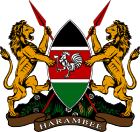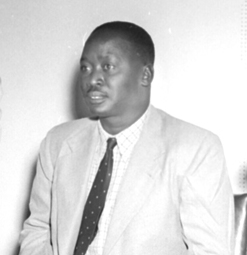 |
|---|
|
Economic schemes |
The New Kenya Party was a political party in Kenya.
 |
|---|
The New Kenya Party was a political party in Kenya.
With encouragement from Governor Evelyn Baring and Secretary of State for the Colonies Alan Lennox-Boyd, the New Kenya Group was established on 2 April 1959 by Michael Blundell. [1] [2] It was the first multi-racial political party in Kenya, and was founded to counter African nationalism and European conservatism. [2] In response, Llewellyn Briggs set up the United Party in August 1959, which opposed common-roll elections, but was defunct by the end of 1960. [3]
In 1960 it became the New Kenya Party, which called for independence with a multiracial coalition government. [2] In the 1961 general elections the party received 3.2% of the vote, winning four of the 53 elected seats in the Legislative Council, and joined the coalition government led by the Kenya African Democratic Union. [4]
The party was dissolved in 1963. [4]

A part of Eastern Africa, the territory of what is known as Kenya has seen human habitation since the beginning of the Lower Paleolithic. The Bantu expansion from a West African centre of dispersal reached the area by the 1st millennium AD. With the borders of the modern state at the crossroads of the Bantu, Nilo-Saharan and Afro-Asiatic ethno-linguistic areas of Africa, Kenya is a truly multi-ethnic state.

The Kenya African National Union (KANU) is a Kenyan political party that ruled for nearly 40 years after Kenya's independence from British colonial rule in 1963 until its electoral loss in 2002. It was known as Kenya African Union (KAU) from 1944 to 1952. The KAU was banned by the colonial government from 1952 to 1960. It was re-established by James Gichuru in 1960 and renamed KANU on 14 May 1960 after a merger with Tom Mboya's Kenya Independence Movement.

Jaramogi Ajuma Oginga Odinga was a Luo chieftain who became a prominent figure in Kenya's struggle for independence. He later served as Kenya's first Vice-President, and thereafter as opposition leader. Odinga's son Raila Odinga is the former Prime Minister, and another son, Oburu Odinga, is a former Assistant Minister in the Ministry of Finance.
Pio Gama Pinto was a Kenyan journalist, politician and freedom fighter. He was a socialist leader who dedicated his life to the liberation of the Kenyan people and became independent Kenya's first martyr in 1965.

General elections were held in Kenya in February 1961. The result was a victory for the Kenya African National Union, which won 19 of the 53 elected seats.

A series of by-elections were held in Kenya on 11 and 12 June 1966, becoming known as the "little general election". They followed the defection of 29 members of the Kenya African National Union (KANU) to establish the Kenya People's Union. As a result, the KANU government passed a constitutional amendment to force the MPs to seek re-election. Although the KPU received the most votes in the by-elections, KANU won more seats.

The Kenya Indian Congress (KIC) was a political party in Kenya.
Sir Michael Blundell was a Kenyan farmer and politician who served as a member of the Legislative Council from 1948 until 1963, and as Minister of Agriculture in two spells between 1955 and 1962.

The Kenya Coalition was a political party in Kenya.

The United Country Party was a political party in Kenya.

The Kenya Freedom Party was a political party in Kenya.

The African People's Party (APP) was a political party in Kenya.

The Party of Independent Candidates of Kenya (PICK) is a political party in Kenya.

The Kenya Social Congress (KSC) is a political party in Kenya. Its symbol is a broom. The party is currently led by Samson Atati Kengere, with Dennis Anyoka as deputy leader.

The Kenya National Democratic Alliance (KENDA) is a political party in Kenya.

The United Party was a political party in Kenya.

The Kenya Independence Movement (KIM) was a political party in Kenya.

The Kenya National Party (KNP) was a political party in Kenya.

The Legislative Council of Kenya (LegCo) was the legislature of Kenya between 1907 and 1963. It was modelled on the Westminster system. It began as a nominated, exclusively European institution and evolved into an electable legislature with universal suffrage. It was succeeded by the National Assembly in 1963.

The presidency of Jomo Kenyatta began in 12 December 1964, when Jomo Kenyatta was named as the 1st president of Kenya, and ended on 22 August 1978 upon his death. Jomo Kenyatta, a KANU member, took office following the formation of the republic of Kenya after independence following his efforts during the fight for Independence. Four years later, in the 1969 elections, he was the sole candidate and was elected unopposed for a second term in office. In 1974, he was re-elected for a third term. Although the post of President of Kenya was due to be elected at the same time as the National Assembly, Jomo Kenyatta was the sole candidate and was automatically elected without a vote being held. He died in 22 August 1978 while still in office and was succeeded by Daniel arap Moi.